Feeding study shows effect of organic vs. inorganic dietary selenium
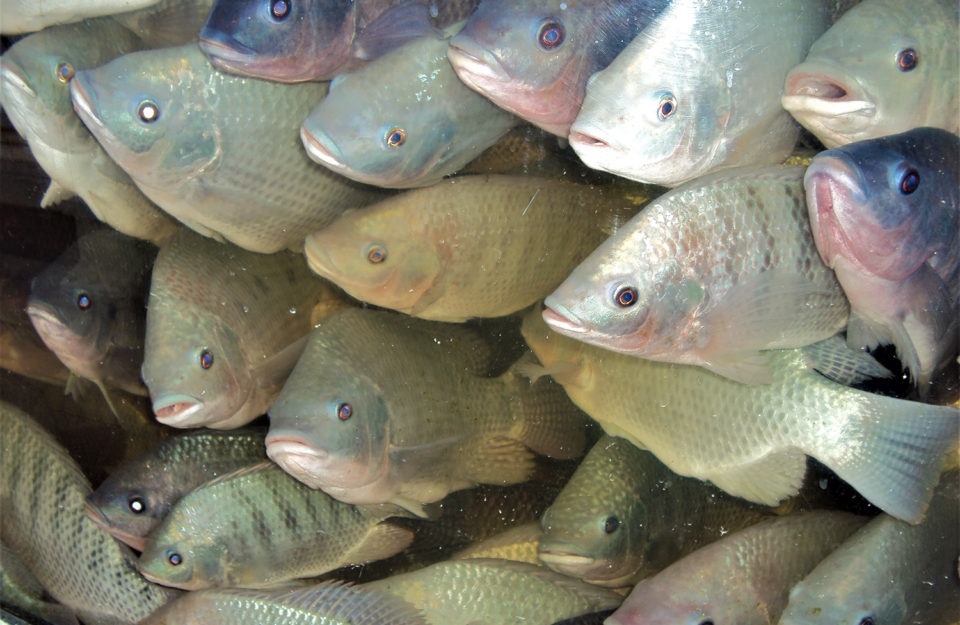
Part 2 of this article – adapted and summarized from the original publication – presents the results of a fish feeding trial conducted to evaluate the effect of Selenium species as functional ingredients in the diet of Nile tilapia (Oreochromis niloticus). Part 1 previously reported on a market survey conducted to evaluate the mineral and heavy metal composition of tilapia fillets available in the U.S. marketplace, and provide information for consumers on potential contribution of consumption of tilapia fillet to mineral contents of their diets.
This study was funded by Virginia Tech’s College of Agriculture and Life Sciences John Lee Pratt Animal Nutrition Program and Interdisciplinary Graduate Education Program (IGEP) water INTERface. The authors also would like to thank Daniel Taylor for help in designing and building the RAS system.
Study setup – fish trial
A seven-week grow-out trial was conducted to evaluate the effect of dietary supplementation of inorganic versus organic selenium (Se) on Nile tilapia. A total of 168 tilapia were acquired from Genetic Spring (Akvaforsk Genetics Center, Miami, Fla., USA). After a month of acclimatization, fish with an average weight of 170 ± 2 grams, (mean ± SE) were randomly stocked into six polyethylene tanks (284 liters each) in a single recirculating aquaculture system (RAS) at 28 fish per tank. The RAS system was equipped with bead and sand filters for mechanical filtration, a bioreactor for nitrification, UV disinfection units, heat exchangers and distributed diffuse aeration.
Two separate isonitrogenous and isoenergetic diets were prepared. The dry ingredients were mixed, followed by the addition of oil and distilled water. Diets were supplemented with 1 mg/kg of Se in forms of sodium selenite (2.83 mg/kg) and seleno-L-methionine (2.19 mg/kg). The concentrations of Se in each diet were measured using Inductively Coupled Plasma Mass Spectroscopy (ICP-MS) analysis, and dietary Se concentration determined to be 2.01 mg/kg for the inorganic Se diet and 2.23 mg/kg for the organic Se diet.
Each diet was fed to fish in triplicate tanks. The amount of feed was adjusted based on the weight gain and feed rates (2 to 3 percent of fish body weight) were consistent between the two treatment groups. Feeding rate was on a percent body weight per day basis. Feed were loaded on 24 belt feeders (four per tank) to deliver feed hourly over an 18-hour period. Fish were weighted weekly and water quality parameters were monitored. Approximately half of the sump tank (95 liters) water was exchanged daily to prevent potential Se accumulation in the water. Also, the Se content of water in each tank was measured at the beginning, middle and end of the experiment to check for any Se accumulation in the tanks.
For detailed information on fish trial experimental design and diet; health and production characteristic of fish; sampling; collections of plasma, fillet, liver, kidney and intestines; total glutathione peroxidase (GPX) enzyme activity measurement; transmission electron microscopy; and statistical assessments, please refer to the original publication.
Results and discussion
There were no significant differences in FCR, weight gain, hepatosomatic index (HSI), viscerosomatic index (VSI), hepatic and plasma GPX activity, or in the intestinal microvilli length of fish from the different treatment groups. Similar results were observed in studies on Crucian carp, juvenile grouper and in rainbow trout by other studies. However, as we hypothesized, feeding the organic form of Se led to a significant increase in Se concentrations observed in kidney, plasma and fillets of the fish. This appears to be due to differences in the absorption, bioaccumulation and bioavailability of different species of Se (organic and inorganic).
Growth performance of fish fed the experimental diets is presented in Table 1. No mortalities were observed during the trial. Fish that were fed organic Se had slight, but insignificantly higher growth and lower FCR than fish fed inorganic Se. There were also no significant differences between the FCR, HSI or VSI of fish fed the different diets.
Farzad, trace minerals in tilapia, Table 1
| Treatment | Survival (%) | Weight gain (g) | FCR | Weekly weight gain (g) |
|---|
Treatment | Survival (%) | Weight gain (g) | FCR | Weekly weight gain (g) |
|---|---|---|---|---|
| Inorganic Se | 100 | 333±101 | 1.43±0.15 | 41.0±6.7 |
| Organic Se | 100 | 362±110 | 1.27±0.08 | 45±5.9 |
Regarding the Se content in fish tissue and plasma, Se concentration was significantly higher in plasma, kidney and fillet of fish fed organic Se (Fig 1). However, the concentration of Se was higher in the liver of fish fed inorganic Se. Overall, Se accumulation was higher in the liver and kidney compared to fillets or plasma compared with the fish fed inorganic Se.
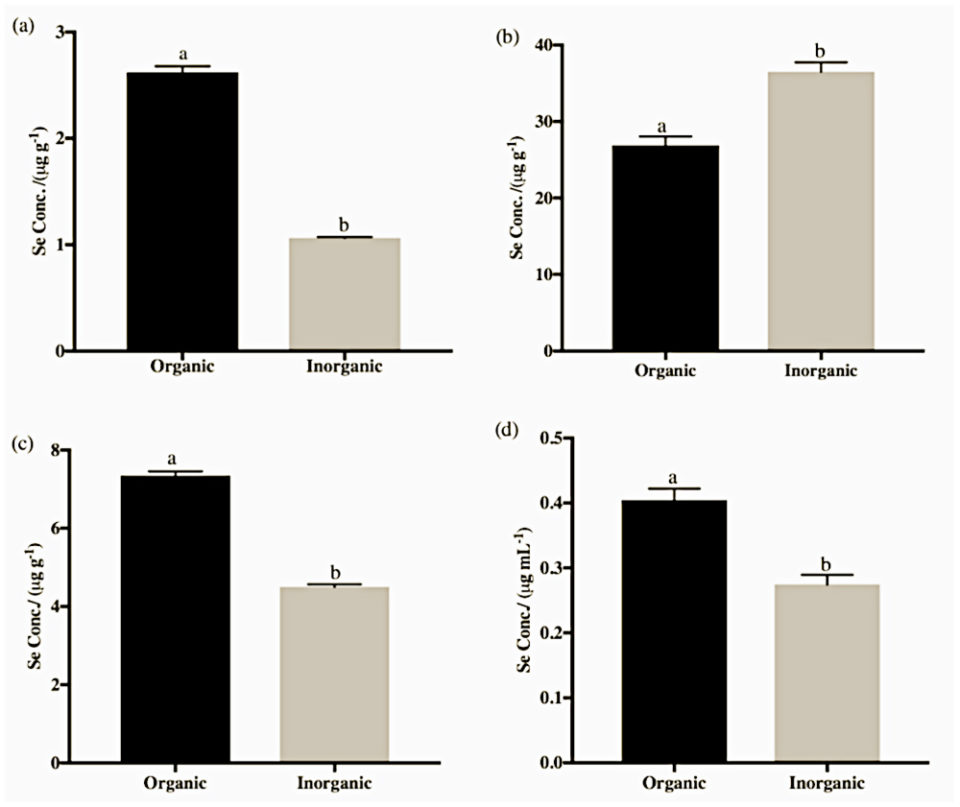
There was no significant difference in total glutathione peroxidase (GPX) enzyme activity in liver or plasma of fish that were fed the different experimental diets. And there were no significant differences between the microvilli from inorganic and organic Se fed group.
Comparing the Se content of tilapia fillets from market to tilapia fillets from fish trial, the organic Se fed tilapia had significantly higher concentrations of Se in comparison to inorganic fed fish or tilapia samples from commercial markets. There were no significant differences between tilapia samples from the market and inorganic fed fish (Fig 2).
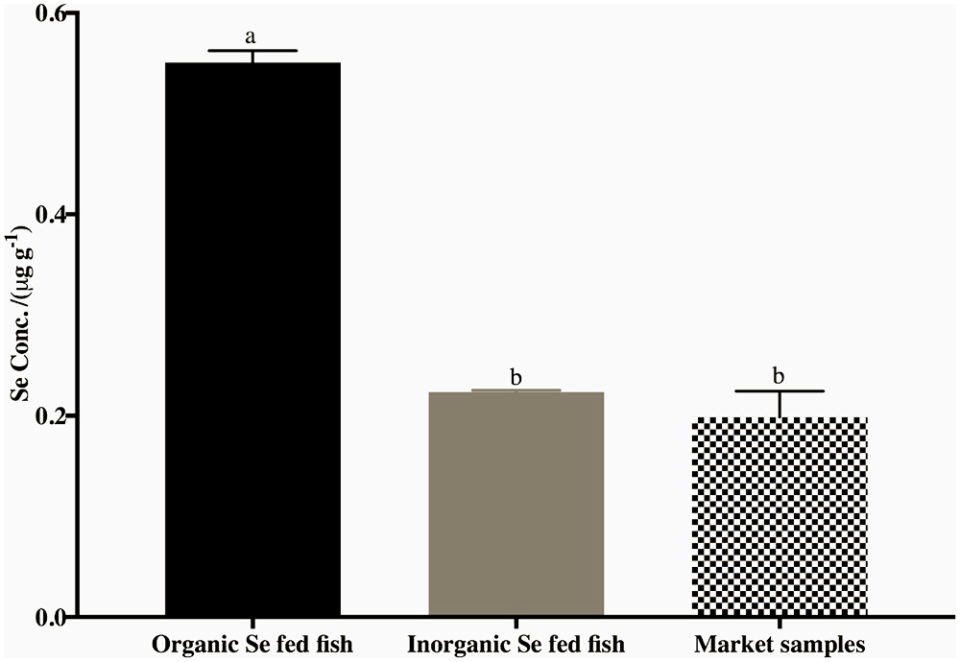
Diets in the fish trial were supplemented with 1 mg/kg of organic or inorganic Se. A dietary Se level of 2.06 mg/kg has been shown to be beneficial for Nile tilapia and this requirement cannot be met by an aquafeed that is not enriched with Se. During the seven-week fish trial, fish demonstrated expected performance. Survival was 100 percent for all the treatment groups with a mean weekly weight gain of 41 and 45 grams for inorganic and organic Se fed fish, respectively.
In our study, a comparison of the concentrations of Se in the tilapia fillets of market samples and fillets from the fish trial showed that fillets from fish fed organic Se had significantly higher Se contents. To maintain normal physiological functions, the Dietary Reference Intake (DRI) for adults is to consume 0.53 μg of Se per day, and for children 4 to 8 years old it is 30 μg of Se per day. A 100-gram serving of the tilapia fillets enriched with organic Se in this study had 0.56 μg of Se, which completely satisfies the recommended intake level per day for both children and adults. However, fillets from the market study and organic Se fed fish had 0.22 and 0.2 μg of Se per serving (100 grams), which can only satisfy 68 percent of the DRI for children and 38 percent of the DRI for adults.
Perspectives
The overall results of this study (parts 1 and 2) highlight the importance of production and promoting the consumption of value-added fish fillets for combating micronutrient deficiency. While undernutrition can be improved by increasing energy intake, micronutrient deficiency is of a different nature and result from inadequate quality of diet.
In poorer households and developing countries, affordability, availability and even cultural acceptability of food from animal sources that are main sources of micronutrients are limited. In this respect, fish offer an advantage as they are more acceptable, more available and consumed by preference in various regions of the developing world. Therefore, promoting the consumption of value-added fish fillets (i.e. Se-enriched) can be used as a whole food approach for solving the problem such as Se deficiency and heavy metal toxicity in developing countries.
Results also demonstrated that organic Se is a more bioavailable form of Se in Nile tilapia. To produce Se enriched tilapia fillets, organic species of Se should be used by the aquaculture industry as an alternative to inorganic species.
Now that you've reached the end of the article ...
… please consider supporting GSA’s mission to advance responsible seafood practices through education, advocacy and third-party assurances. The Advocate aims to document the evolution of responsible seafood practices and share the expansive knowledge of our vast network of contributors.
By becoming a Global Seafood Alliance member, you’re ensuring that all of the pre-competitive work we do through member benefits, resources and events can continue. Individual membership costs just $50 a year.
Not a GSA member? Join us.
Authors
-
Razieh Farzad, Ph.D.
Department of Food Science and Technology
Virginia Polytechnic Institute and State University
Blacksburg, Virginia, USA -
David D. Kuhn, Ph.D.
Corresponding author
Department of Food Science and Technology
Virginia Polytechnic Institute and State University
Blacksburg, Virginia, USA -
Stephen A. Smith, DVM, Ph.D.
Department of Biomedical Sciences and Pathology
Virginia-Maryland College of Veterinary Medicine
Blacksburg, Virginia, USA -
Sean F. O’Keefe, Ph.D.
Department of Food Science and Technology
Virginia Polytechnic Institute and State University
Blacksburg, Virginia, USA -
Nicholas V.C. Ralston, Ph.D.
Department of Earth System Science & Policy
University of North Dakota
Grand Forks, North Dakota, USA -
Andrew P. Neilson, Ph.D.
Department of Food Science and Technology
Virginia Polytechnic Institute and State University
Blacksburg, Virginia, USA -
Delbert M. Gatlin, Ph.D.
Department of Fisheries and Wildlife Sciences
Texas A&M University
College Station, Texas, USA
Tagged With
Related Posts
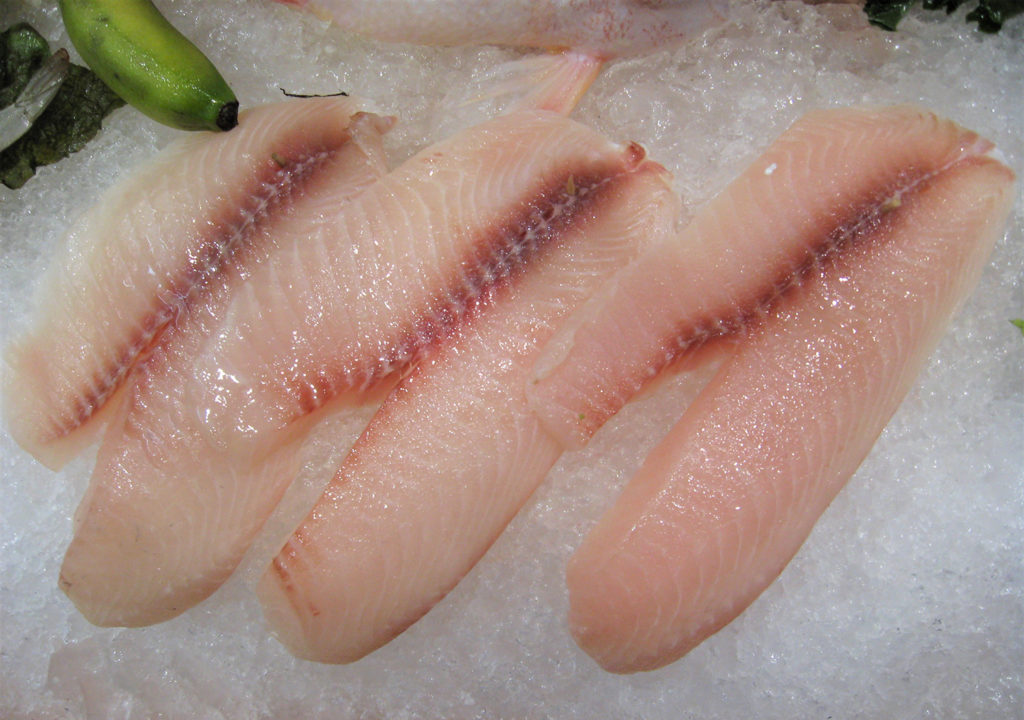
Intelligence
Trace minerals in tilapia fillets, part 1
Part 1 of this study highlighted the importance of minerals in the diet of fish for meeting micronutrient requirements in the human diet.
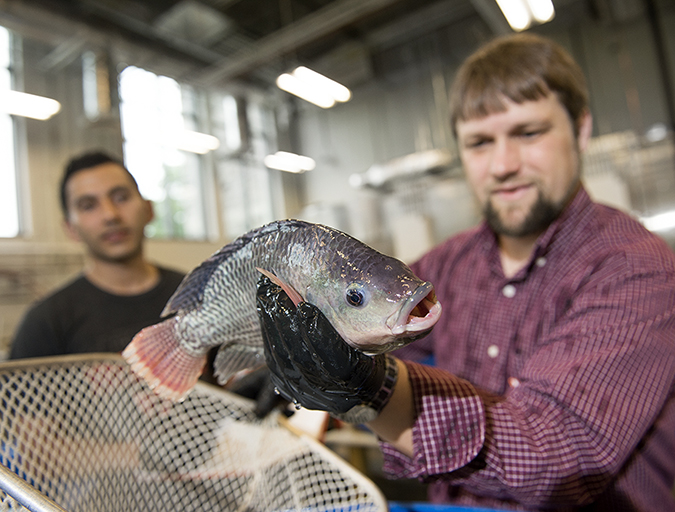
Intelligence
U.S. universities collaborate on antibiotic alternative project
Two U.S. universities are teaming up to study the application of a novel antibody to tilapia to reduce the aquaculture industry’s use of antibiotics. The chairman of the Seafood Industry Research Fund says there could be a disruptive financial impact on seafood if it can’t compete in the “antibiotic-free” space.
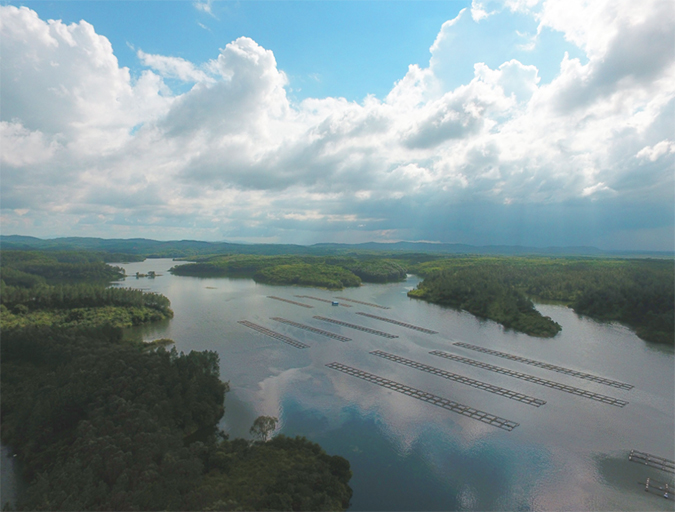
Intelligence
What will it take to make tilapia great again?
Once a darling of the sustainable seafood crowd for its vegetarian diet and potential to feed the world’s growing population, mild-mannered tilapia now has an image problem that may be causing a dip in consumption levels.
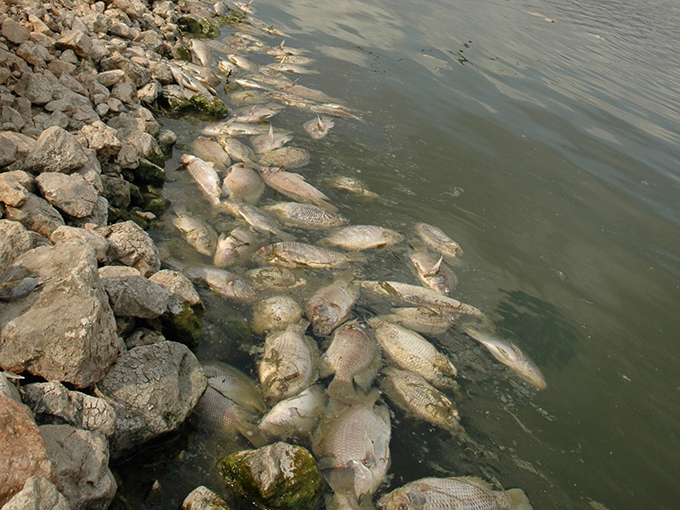
Health & Welfare
Sizing up TiLV and its potential impact on tilapia production
An international research effort has commenced to find a solution for Tilapia Lake Virus (TiLV), a contagion causing high rates of mortality in farmed and wild tilapia stocks in Israel, Colombia, Ecuador, Egypt and Thailand.


